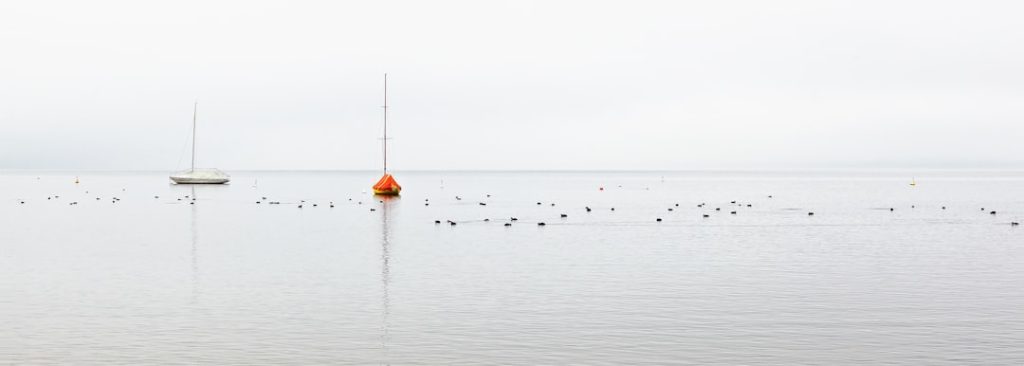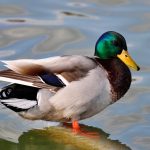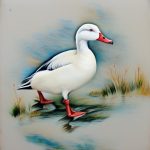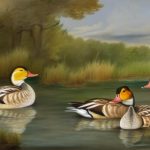North American black and white duck breeds are a diverse group of waterfowl that are highly valued for their beauty, versatility, and utility. These breeds are known for their striking black and white plumage, which sets them apart from other duck breeds. They are popular among breeders and enthusiasts for their unique appearance and their ability to thrive in a variety of environments. North American black and white duck breeds have a rich history and have been an important part of the agricultural landscape for centuries. They are raised for their meat, eggs, and feathers, and are also kept as ornamental birds. In recent years, there has been a renewed interest in conserving and preserving these breeds, as they are considered to be important genetic resources for the future.
Table of Contents
- 1 Characteristics and Physical Appearance of Black and White Duck Breeds
- 2 Popular Black and White Duck Breeds in North America
- 3 Breeding and Rearing Black and White Duck Breeds
- 4 Housing and Care for Black and White Duck Breeds
- 5 Uses and Purposes of Black and White Duck Breeds
- 6 Conservation and Preservation Efforts for North American Black and White Duck Breeds
- 7 FAQs
- 7.1 What are North American black and white duck breeds?
- 7.2 What are some examples of North American black and white duck breeds?
- 7.3 What are the characteristics of North American black and white duck breeds?
- 7.4 What are the uses of North American black and white duck breeds?
- 7.5 What are the care requirements for North American black and white duck breeds?
Key Takeaways
- North American black and white duck breeds are popular for their unique coloration and characteristics.
- These duck breeds are known for their striking black and white plumage, with variations in patterns and markings.
- Some popular black and white duck breeds in North America include the Magpie, Cayuga, and Silver Appleyard.
- Breeding and rearing black and white duck breeds require proper care, nutrition, and attention to their specific needs.
- Providing suitable housing and care is essential for the health and well-being of black and white duck breeds, including access to water for swimming and foraging.
Characteristics and Physical Appearance of Black and White Duck Breeds
North American black and white duck breeds are known for their distinctive coloration, which is characterized by a combination of black and white feathers. These breeds come in a variety of sizes, with some being small and compact, while others are larger and more robust. They have a sleek and streamlined body shape, with a slightly elongated neck and a broad, flat bill. Their legs are set far back on their bodies, which makes them excellent swimmers. The plumage of these breeds is typically glossy and iridescent, with a striking contrast between the black and white feathers. Some breeds may also have unique markings or patterns, such as speckles or spots. Overall, North American black and white duck breeds are known for their elegant and eye-catching appearance, which makes them popular choices for both exhibition and practical purposes.
Popular Black and White Duck Breeds in North America
There are several popular black and white duck breeds that are commonly found in North America. One of the most well-known breeds is the Magpie duck, which is prized for its striking black and white plumage and friendly disposition. Magpie ducks are medium-sized birds with a calm and sociable nature, making them ideal for backyard flocks. Another popular breed is the Cayuga duck, which is known for its iridescent greenish-black plumage that shimmers in the sunlight. Cayuga ducks are excellent foragers and are valued for their high-quality meat and eggs. The Silver Appleyard duck is another popular breed, known for its striking silver and white plumage and its excellent egg-laying abilities. These ducks are also prized for their calm temperament and adaptability to various climates. Other popular black and white duck breeds in North America include the Ancona duck, the Welsh Harlequin duck, and the Saxony duck, each with its own unique characteristics and qualities.
Breeding and Rearing Black and White Duck Breeds
Breeding and rearing black and white duck breeds requires careful attention to genetics, health, and environmental factors. When breeding these ducks, it is important to select birds with desirable traits such as good conformation, coloration, and temperament. Breeding programs should aim to maintain genetic diversity within the population to ensure the long-term viability of the breeds. Rearing black and white duck breeds involves providing them with a suitable environment that meets their specific needs. This includes access to clean water for swimming, a balanced diet that meets their nutritional requirements, and protection from predators and extreme weather conditions. Ducklings should be raised in a warm and secure brooder until they are old enough to be introduced to an outdoor enclosure. Proper care and management are essential for the health and well-being of black and white duck breeds, especially during the breeding and rearing process.
Housing and Care for Black and White Duck Breeds
Housing and care for black and white duck breeds should be tailored to meet their unique requirements as waterfowl. Ducks require access to clean water for swimming, feeding, and preening, so their housing should include a suitable water source such as a pond or shallow pool. The housing should also provide protection from predators, adequate ventilation, and insulation to keep the ducks comfortable in various weather conditions. Bedding material such as straw or wood shavings should be provided to keep the housing clean and dry. Ducks should also have access to a balanced diet that includes grains, greens, insects, and commercial feed to meet their nutritional needs. Regular health checks, parasite control, and vaccination programs should be implemented to ensure the well-being of the ducks. Overall, providing proper housing and care is essential for the health and productivity of black and white duck breeds.
Uses and Purposes of Black and White Duck Breeds

Black and white duck breeds have a variety of uses and purposes that make them valuable to farmers, breeders, and enthusiasts. These ducks are raised for their meat, which is known for its rich flavor and succulent texture. They are also valued for their eggs, which are larger than chicken eggs and have a rich yolk that is prized by bakers and chefs. The feathers of black and white duck breeds are used in various crafts such as fly tying, quilting, and clothing accessories. In addition to their practical uses, these ducks are also kept for ornamental purposes due to their striking appearance and friendly demeanor. They are often featured in exhibitions, fairs, and agricultural shows where they attract attention with their unique coloration and elegant presence. Overall, black and white duck breeds serve multiple purposes that make them valuable assets to small-scale farms, homesteads, and conservation efforts.
Conservation and Preservation Efforts for North American Black and White Duck Breeds
Conservation and preservation efforts for North American black and white duck breeds are important for maintaining genetic diversity and ensuring the long-term survival of these valuable resources. Several organizations, breed clubs, and individuals are actively involved in conserving rare and heritage duck breeds through breeding programs, education, advocacy, and outreach activities. These efforts aim to raise awareness about the importance of preserving genetic diversity within domesticated animal populations. Conservation programs often involve identifying rare or endangered breeds, establishing breeding standards, maintaining pedigree records, and promoting responsible breeding practices. In addition to conservation breeding, efforts are also made to promote the use of black and white duck breeds in sustainable agriculture, small-scale farming, and backyard poultry keeping. By supporting conservation initiatives, individuals can contribute to the preservation of North American black and white duck breeds for future generations to enjoy.
In conclusion, North American black and white duck breeds are valued for their unique coloration, versatility, utility, and cultural significance. These breeds have a rich history and play an important role in agriculture, conservation, and sustainable living. By understanding their characteristics, uses, care requirements, and conservation needs, individuals can contribute to the preservation of these valuable genetic resources for future generations to appreciate. Whether raised for meat, eggs, feathers, or ornamental purposes, black and white duck breeds continue to captivate people with their beauty, charm, and practicality in diverse settings across North America.
If you’re interested in learning more about North American black and white duck breeds, you might also want to check out this informative article on how to insulate a chicken coop on PoultryWizard. Proper insulation is crucial for maintaining a comfortable environment for your poultry, and this article provides valuable tips and techniques to help you keep your chickens warm and cozy during the colder months. Learn more here.
FAQs
What are North American black and white duck breeds?
North American black and white duck breeds are domestic duck breeds that are primarily black and white in coloration. These breeds are popular for their striking appearance and are often kept for ornamental and exhibition purposes.
What are some examples of North American black and white duck breeds?
Some examples of North American black and white duck breeds include the Cayuga duck, the Magpie duck, and the Silver Appleyard duck. These breeds are known for their distinctive black and white plumage and are prized for their beauty and elegance.
What are the characteristics of North American black and white duck breeds?
North American black and white duck breeds are typically medium to large in size with a broad, rounded body. They have a distinctive black and white color pattern, with variations in markings and patterns depending on the specific breed. These ducks are known for their friendly and docile temperament.
What are the uses of North American black and white duck breeds?
North American black and white duck breeds are primarily kept for ornamental and exhibition purposes. They are also raised for their meat and eggs, although they are not as commonly used for commercial production as other duck breeds. Additionally, these breeds are valued for their ability to control pests and for their potential as pets.
What are the care requirements for North American black and white duck breeds?
North American black and white duck breeds require a suitable living environment with access to water for swimming and foraging. They also need a balanced diet that includes commercial duck feed, fresh water, and access to forage. Proper shelter and protection from predators are also important for their well-being. Regular health checks and proper veterinary care are essential for maintaining their health and well-being.
Meet Walter, the feathered-friend fanatic of Florida! Nestled in the sunshine state, Walter struts through life with his feathered companions, clucking his way to happiness. With a coop that’s fancier than a five-star hotel, he’s the Don Juan of the chicken world. When he’s not teaching his hens to do the cha-cha, you’ll find him in a heated debate with his prized rooster, Sir Clucks-a-Lot. Walter’s poultry passion is no yolk; he’s the sunny-side-up guy you never knew you needed in your flock of friends!







